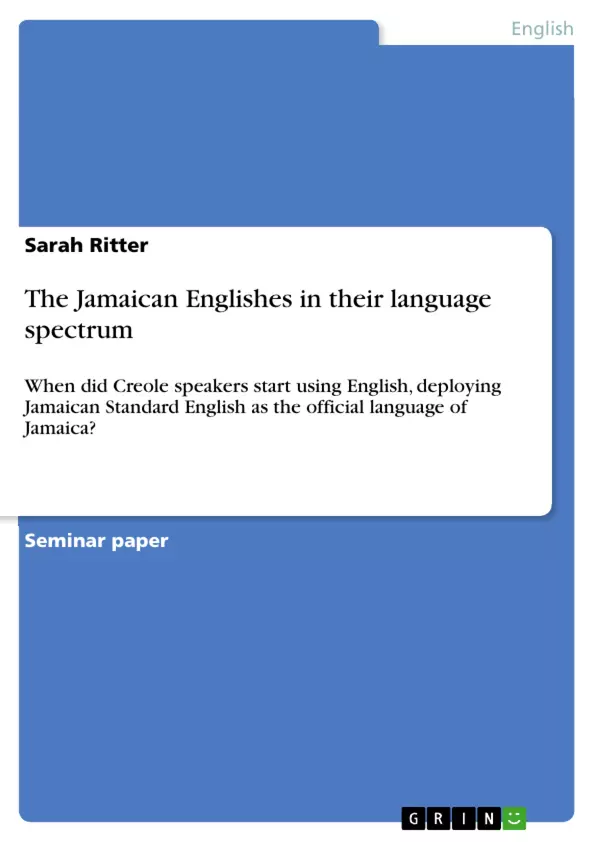The spread of the English language was primarily due to colonization and colonial policies instigated by Great Britain and its Crown. The location of concern for this term paper is the Caribbean, especially the largest former British colony in the Caribbean – Jamaica. The Island is of multiple English-speaking countries. It is interesting to explore the two variants linguistically, Standard Jamaican English and the English-based Jamaican Creole that have existed almost since colonization. However, we cannot get headfirst into the linguistic features of languages like Jamaican Standard English and Jamaican Creole. Firstly, there is a need to establish the history of the Jamaican languages, its current state, and perhaps even a prevision into the future.
Inhaltsverzeichnis (Table of Contents)
- Introduction
- Colonial and Postcolonial Linguistic History of Jamaica
- Standard Jamaican English
- Function and Role of Standard Jamaican English
- English-based Jamaican Creole
- Function and Role of Jamaican Creole
- Linguistic features of English-based Creole and Standard Jamaican English
- The development of Jamaican Languages and their use
- Evolutions in Schneider's Dynamic Model
- Conclusion
Zielsetzung und Themenschwerpunkte (Objectives and Key Themes)
This term paper aims to investigate the emergence and development of Jamaican Standard English (SJE) as an official language in Jamaica, specifically focusing on the transition from Jamaican Creole (JC) to SJE. The paper delves into the historical, linguistic, and social factors that have shaped the language landscape of Jamaica.
- The historical development of Jamaican languages from colonial influences to the present day
- The function and role of both Standard Jamaican English and Jamaican Creole in Jamaican society
- The linguistic features that differentiate and connect Standard Jamaican English and Jamaican Creole
- The dynamic relationship between Standard Jamaican English and Jamaican Creole in the Jamaican language spectrum
- The ongoing evolution of Jamaican languages and their impact on the linguistic landscape of Jamaica
Zusammenfassung der Kapitel (Chapter Summaries)
The first chapter introduces the context of Jamaican English and its significance in the wider context of world Englishes. It highlights the historical roots of the language, emphasizing the impact of colonization and the presence of both Standard Jamaican English and Jamaican Creole.
The second chapter delves into the colonial and postcolonial linguistic history of Jamaica, tracing the development of Jamaican Creole. It examines the role of enslaved Africans and their languages in shaping the language spectrum, discussing the influence of English, Spanish, and West African languages.
The third chapter focuses on Standard Jamaican English, exploring its function and role in Jamaican society. It examines the sociolinguistic context and the relationship between Standard Jamaican English and Jamaican Creole.
The fourth chapter focuses on English-based Jamaican Creole, examining its function and role in Jamaican society. It explores the historical development of the creole language, highlighting the contributions of various influences and its evolution over time.
The fifth chapter delves into the linguistic features of both Standard Jamaican English and Jamaican Creole, examining their similarities and differences. It analyzes the grammatical and lexical variations between the two languages, shedding light on their unique characteristics.
The sixth chapter explores the development of Jamaican languages and their use, examining the dynamic relationship between Standard Jamaican English and Jamaican Creole. It incorporates Schneider's Dynamic Model to understand the evolutionary process of pidgins into creoles, and the ongoing interaction between the two language varieties.
Schlüsselwörter (Keywords)
The key terms and concepts explored in this paper include Jamaican Creole, Standard Jamaican English, language contact, creolization, pidginization, language spectrum, colonialism, postcolonialism, linguistic history, sociolinguistics, and the Dynamic Model of language change.
- Quote paper
- Sarah Ritter (Author), 2022, The Jamaican Englishes in their language spectrum, Munich, GRIN Verlag, https://www.grin.com/document/1323315



